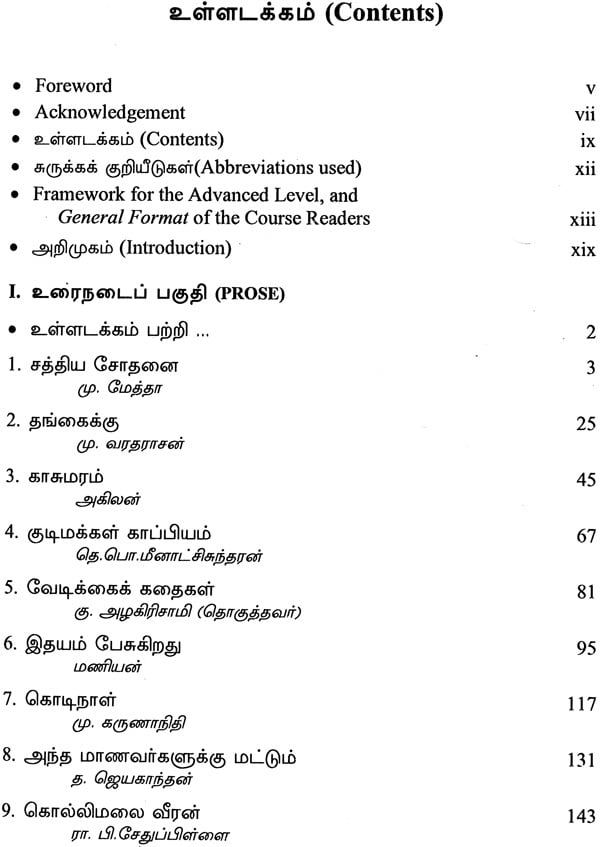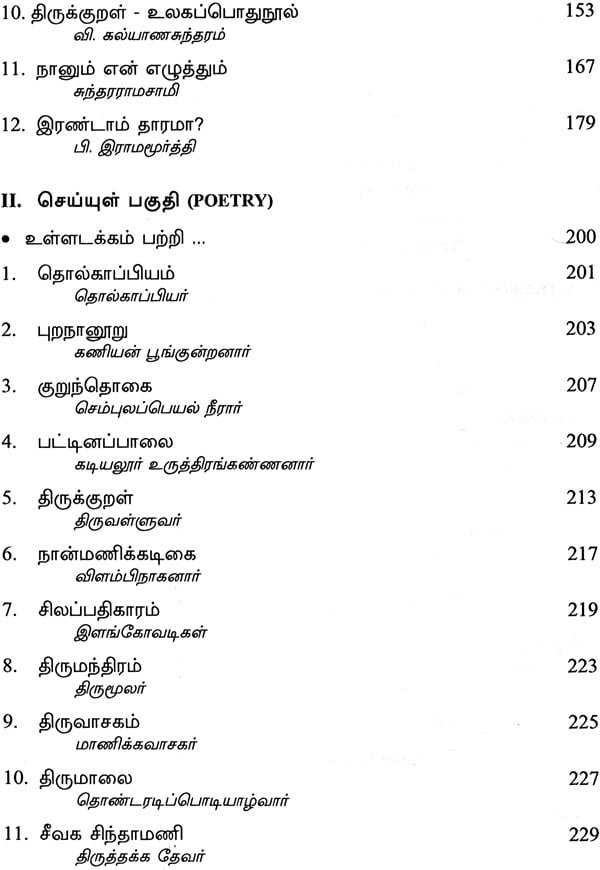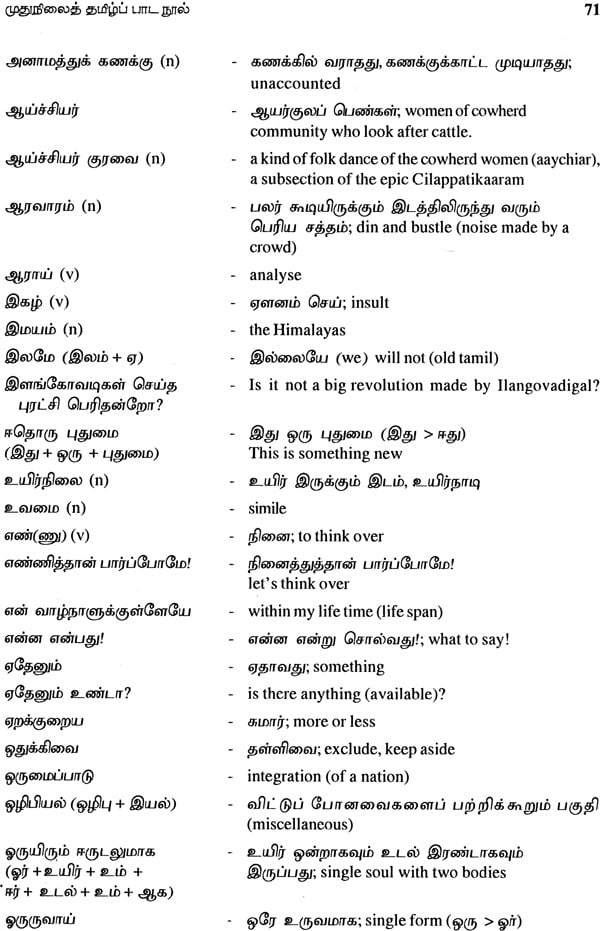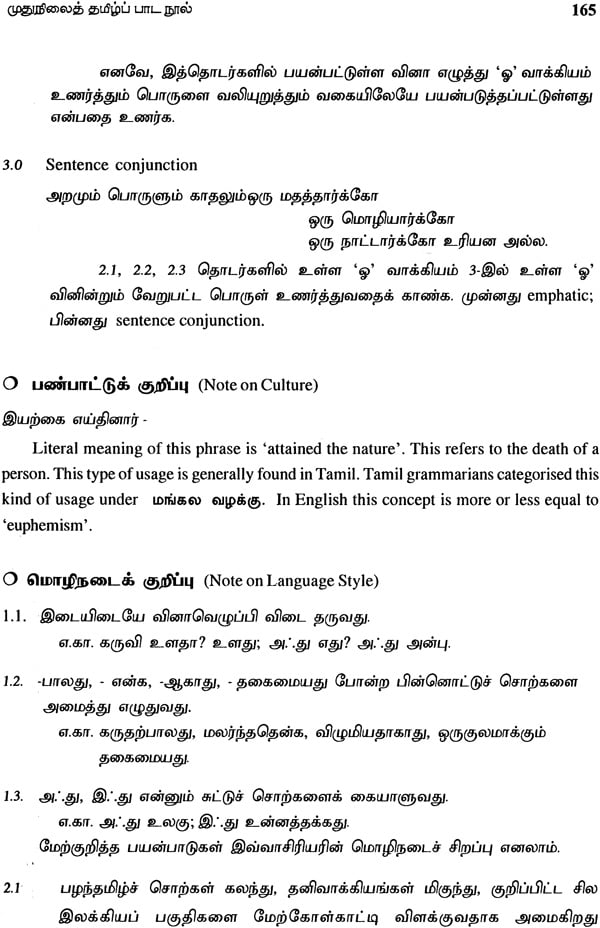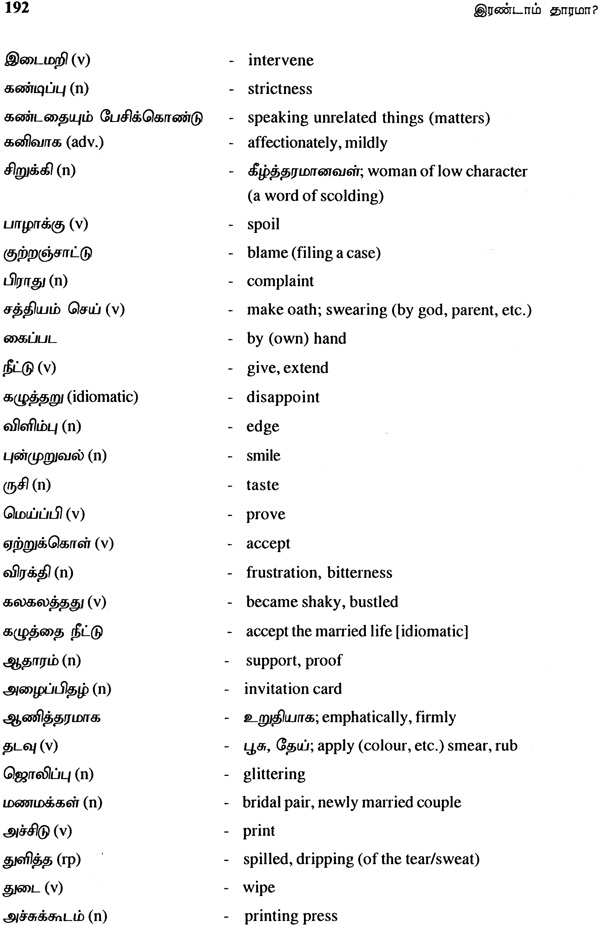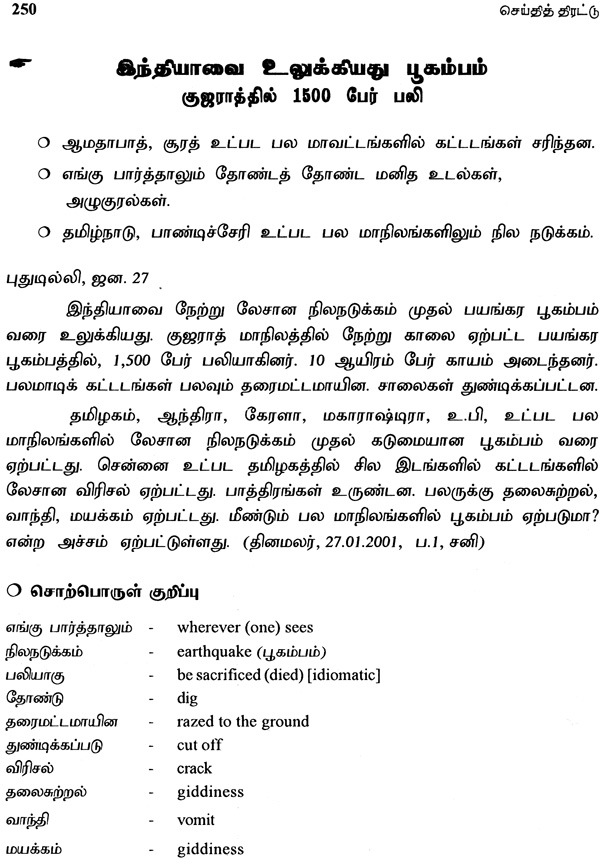
Advanced Course Reader in Tamil (For the Non-Tamils Learning Tamil as Second Language)
Book Specification
| Item Code: | NAK539 |
| Author: | Pon Subbiah |
| Publisher: | Central Institute Of Indian Languages, Mysore |
| Language: | Tamil Text with English Translation |
| Edition: | 2010 |
| ISBN: | 8173420971 |
| Pages: | 335 |
| Cover: | Hardcover |
| Other Details | 9.5 inch x 6.5 inch |
| Weight | 620 gm |
Book Description
Foreword
The Central Institute of Indian Languages was established on 17th July 1969 with a primary objective of fulfilling the Government of India’s resolution that envisaged a set of concrete measure for the development of the major Indian languages. As an important step in this direction, the Institute opened seven Regional Language Centres (RLCs) in different parts of the country for implementing the 3 language formula of the Govt. of India.
As part of this mission, the RLCs are offering a ten month intensive teaching-cum-training programme in most of the scheduled Indian languages to the secondary school teachers. The admission for this programme is given to the teachers who are deputed from various States/UTs of the country to learn the languages which are other than their mother tongues. This intensive programme is divided into 3 levels: Basic, Intermediate and Advanced. The materials and methodologies required for this purpose were assigned to various members of RLC faculty. Accordingly, Advanced Course Reader in Tamil, the main text meant for the advanced level, was prepared by Pon Subbiah when he was working in the Southern Regional Language Centre, and later in the Centre for Testing & Evaluation of the CIIL.
The material has been used by several batches of Non-Tamil Teachers who were learning Tamil as L2. Based on the feedback obtained from them, it has now been improved and revised by Dr. Subbiah himself. The harllmark of this work is its pedagogical approach with a number of lesson components, thus making it distinct from many other readers. The inclusion of the General Format used for preparing this material, is another useful step for the benefit of the future generation. I hope this edition will help the learners to enhance their skill of using the language in wider contexts, and also to heighten the awareness of the diversity of Indian culture. No doubt, it will be an impetus to the Institute’s wealth of L2 resources enriching the area of language pedagogy.
Introduction
The Southern Regional Language Centre (SRLC) Mysore, one of the seven RLCs of the CIIL, has been involved in the teaching of Tamil as second language (L2) to the non-Tamil graduate teachers of different disciplines. These teachers are mainly drawn from the schools rub by the Central, State, and Union Territory governments of the Indian Union. The purpose of this programme is to create a band of trained teachers to teach Tamil as second of third language (L2 or L3) in various schools under the Govt. of India policy of three language formula.
The programme of teaching Tamil as L2 is a 3 level (basic, intermediate, and advanced) comprehensive course with about 1100 clock hours of intensive teaching spread over a span of 10 moths duration. The quantum of language being learnt in this programme, is expected to be equivalent to the 10 years of learning in the native language (L1). The basic level of this programme is meant to introduce the structural patterns of the language; intermediate level is to provide cultural aspect through controlled structures; and the advanced level is designed to highlight the free usage of language in different styles (by different authors) through a variety of samples from archaic to modern.
The learners of the advanced level are given reinforcement of the skills of language (already acquired at the basic and intermediate levels) through environment study tours to various geographical areas inhabited by the native speakers. Thus, the main focus at this level is to train the learners overcome the difficulties arising out of acculturation and inter-language; the other focus is the help them (i) make use of the target language (TL) acquired in unpredictable situations (ii) exploit the thematic content and language of the material available and (iii) develop and interest in appreciating the literary works of the TL besides kindling an urge to know the origin and development of that language.
Mudunilait tamilp paadanuul (Advanced Course Reader in Tamil) prepared for fulfilling the above requirements, is meant to serve as a main teaching material at the advanced level of this comprehensive programme. It consists of 3 parts, with 12 samples of prose pieces under Part I, 18 samples of poetry pieces under Part IT, and 7 sample-sets of current usages under Part III.
The first lesson under part I 'prose' is cattiya cootanai [experiment with truth] a short story as seen in a railway platform and subsequently in an unreserved compartment of a passenger train; it is a symbolic representation of the society as how it treats those who are gentle in behaviour and at the same time how it compromises with those who are rough; being presented as an anecdote, it is written in a narrative style. The second one, tankaikku [to sister] is a letter by a scholar addressed to his sister; the theme of the letter is family life which is presented in a typical literary style. Kaacumaram [tree of coins], the third lesson, is a short story depicting the death of a poverty stricken female child; filled with a variety of spoken forms, and usages, it is presented in a simple narrative style. Kutimakkal kaappiyam [epic of common people] is the fourth lesson; it explains the unique features of the Tamil epic cilappatikaaram and is presented in a formal literary style. The next one veetikkaikkataikal [humourous stories] is a compilation of three short stories. Being the translated versions of the folk tales of British and German origin, they are presented in a simple narrative style that was prevalent during 1940s. The sixth lesson, ita yam peecukiratu [heart speaks] is a travelogue; the encounters of an orthodox brahmin family who travelled through Japan are highlighted here; a kind of language with code-switching and mixing of words (from English and Sanskrit) is predominantly used here.
Kotinaal [flag day], the next lesson, is a transcribed version of a speech delivered by a film script writer and poet-turned-political leader; it is in an elevated poetic style with simple structure. The eighth lesson anta maanavarkalukku mattum [only for those students] focuses the evils that surround those adolescent students who are alcoholic addicts; the author reminds them of their social responsibility; presented in a popular dialect using code-switching style. Kollimalai viiran [hero of kolli-hills], the nineth one, narrates the valour of a chieftain who ruled the kolli hill region, as described in one of the Tamil classics; presented in an elegant poetic style, it consists of a variety of attributive phrases. The next one tirukkural- ulakap potunuul [divine couplet- a universal treatise] provides the glory of tirukkural, the masterpiece of Saint Thiruvalluvar; a unique style of writing, a factor that gives the author a special entity (during the first half of the zo" century). Eleventh lesson naanum en eluttum [I and my writing] is a typical example of the usage of a freelancer; presented in a style with full of complex structures coupled with idiosyncratic features; it highlights the author's introspection. The last one irantaam taaramaa? [second wife ?] is a dramatised presentation of a judicial argument that took place in a court of law on a case of bigamy; this piece of writing which appeared in a popular Tamil weekly dated back to 1970s is accommodated due to its rich vocabulary and specialised usage of language specific to judiciary.
Part II 'poetry' consists of a number of samples. They are presented in a chronological order based on the History of Literature by Mu. Varadarajan. The first item included, is a sample from tolkaappiyam, the earliest extant Tamil grammar. The second and third ones are from puranaanuuru and kuruntokai, constituents of the "ettuttokai" (eight anthologies) of cankam period. Pattinappaaiai, the fourth item is a sample from "pattuppaattu'' (anthology of ten long poems) of the same period. The fifth and sixth ones are the samples from tirukkural and naanmanikkatikai respectively; they are the constituents of "patinenkiilkanakku" (a compilation of eighteen minor works) the age of which is considered as next to the cankam period. The seventh one is a piece from cilappatikaaram, one of the five great epics of Tamil. The next one is a sample from tirumantiram, a work on Saiva philosophy. Tiruvaacakam, one of the constituents of "pannirutirumurai'' (a list of 12 classified devotional poems) of Saiva religion, is the nineth one. Tirumaalai, the tenth one, is a sample from the naalaayirat tivyap prapantam (a compilation of 4000 devotional poems) of Vaishnava religion.
A sample piece from ciivaka cintaamani (another constituent of the five great epics of Tamil which advocates Jainism) is included as the eleventh item. Then comes a poem from kambaraamaayanam (a monumental work of the poet Kamban) of the medieval period. It is followed by a piece from kalingattupparani, one of the minor literary works of latter period belonging to a genre called 'parani'. The fourteenth one consists of a few samples from aatticuuti, a classic example of 'one line verse' that teaches moral and ethics; the uniqueness of this work is that the first letter of the first word in each line is arranged in alphabetical order. The fifteenth and sixteenth items are baarata camutaayam and cankanaatam, poetry pieces drawn from the works of Bharathiar and Bharathidasan, poets of early and mid 20th century respectively. This is followed by a sample of tiraiyicaip paatal (film song) by Kannadasan, a renowned poet of the zo" century. Eighteenth, the last item, consists of a few samples drawn from putuk kavitaikal (different shades of free verses) viz.,. avadaaram (incarnation), paci (hunger), swatantiram (independence), tukkam (grief), koolam (rangoli), anaatai (orphan), and vaalkkai (life). These shades belong fo the categories of 'haikkuu', and 'space poetry'.
The first set of samples under part III 'usages', is ceytittirattu (a collection of news items) picked up from Dinamalar, a popular Tamil daily. The second one is ciripputtunukkukal (wits and bits) from Anandavikadan, a popular Tamil weekly. Tunukkucceytikal (news bits / titbits) is the third item, drawn from the same weekly. The next one alaippitalkal (invitations) reflects a variety of usages (that are in vogue in day to day events) as noticed in the invitation cards/letters meant for marriage functions, house warming ceremonies, etc. This is followed by aluvalakak katitankal / kurippukal (official letters / notes); filled with a variety of official communications such as circulars, government orders, internal notings, etc. Sixth one is caanritalkal (certificates); samples of usage as found in the certificates / testimonials issued by various schools, colleges, and universities. Seventh and the last one is varuvaaytturai aavanankal (revenue records) such as sale deed, registration document, money receipt, possession certificate, etc.
Selection of passages : As the Advanced Course Reader is intended to give an overall idea about the usage of the TL, adequate steps have been taken to incorporate representative samples of all available varieties of language. While doing so, balance is maintained in the distribution of ideational contents as well as generic categories. The learners' entry behaviour, heterogeneity of their background, age range, interests, etc., have been kept in mind while selection was made. Familiarity in the theme, syntactic complexity, semantic patterns etc., have formed a basis for determining the selection criteria. Due consideration has also been given to socio-linguistic factors like dialects, etc. In addition, the feed-back obtained from different batches of trainees, has contributed a lot in deciding the suitability of the samples. As for the number of prose pieces is concerned, the suggestion made in the general format has slightly been deviated; due to the fact that the passages identified (for inclusion) are very lengthy and editing them beyond certain reasonable extent might result in losing their significance / importance.
Gradation: For this type of material, the principles of gradation such as simple to complex, known to unknown, abstract to concrete, etc., cannot be followed strictly especially for the prose lessons due to the following reasons: Structure based gradation has not been possible as each one of the passages consists of almost all types of structures. Theme or content also cannot form a basis as each lesson included here consists of an equally important theme and content. Length of the passage too cannot be used as a basis because learning difficulty is not caused merely by length alone but there are other factors too. Same is the case with the chronological order, as dates of the majority of pieces included here have fallen more or less in the same period. Hence, the only basis that could be considered reasonable (for grading the passages) was the overall difficulty. Such a difficulty though somewhat impressionistic, has been perceived as a combination of various factors such as nature of content information, coherence, style of language used, range of vocabulary, syntactic complexity, semantic variations, and contexts of usage. The question of adopting such criteria to the poetry lessons (included under part 11), however, does not arise because the intention here is to provide mainly the trends and sequences that were prevalent from time to time, in the literary history of the TL.
Lesson Components: As per the suggestion made under sl. no. 5. of the 'General Format of the Advanced Course Reader, each prose lesson under part-I, has broadly been structured with the following components i.e., note on the author, body of the text, vocabulary, special phrases & sentences, culture, grammar, language style, and exercises. Details of them are as follows:
Note on the author: Various information’s such as the details of other literary works if any produced by the same author, their significance for the language studies, etc., are provided under this note. It is incorporated as a starting point just before the body of the text in the case of prose lessons and in case of poetry at the end of the main text.
Note on vocabulary : Difficult words and phrases have been listed here along with contextual meanings either in Tamil or in English (or in both sometimes) with a view to have clarity. Words of Sanskrit and English origin have been shown separately with Tamil equivalents. In most cases, they are supplemented with lexical/literal meanings as well as antonyms". An alphabetical order has been followed for listing the difficult words for 5 lessons (s1.nos. 1,3,4,5,6) in order to facilitate the learners get familiar with the use of dictionaries (which is one of the essential objectives to be achieved) ; for the remaining 7 lessons (s1.nos. 2, 7, 8, 9, 10, 11, 12), the difficult words have been listed in the order of their occurrence in the text. This would facilitate the learners to skim the text for locating the words concerned, and also to acquire the skill of reading with understanding (skimming and scanning). Such a note has also been provided for the poetry as well as the lessons on specialised usages. The total no. of vocabulary items thus provided in all the 3 parts put-together may workout to be about 2000 and for most of which the grammatical entities have also been indicated in parenthesis.
